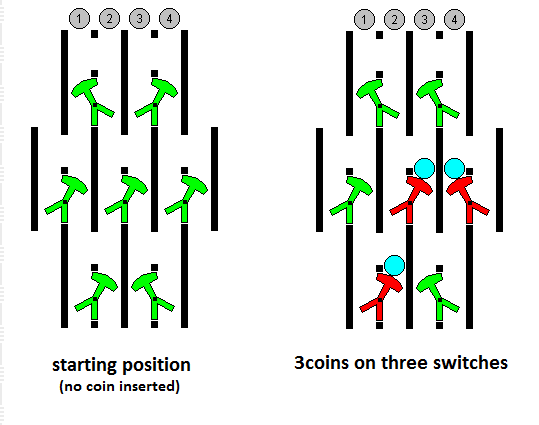First of all if either of the top two switches has a coin on it, drop another to clear it. Now, if either of them are leaning in (and by leaning I always mean the top of the switch leaning that way), drop a coin on their outside so that lean out. From now on we will only ever hit a top-row switch with pairs of coins (one each side), so they will always stay clear and lean out. (until the final two or coins, anyway!)
Now, if the central switch has a coin on it, drop a pair of coins on either top-row switch. One of them will fall through and clear the central switch. We will also be keeping the central switch clear until right near the end.
Observe that we can now drop a set of four coins one each into the four slots - in any order - and these three switches will all end up clear, and the top row leaning out.
Consider the outside switches on the middle row. After the first coin strikes them, they can only ever lean in. Let's drop a set of four coins so we know they're leaning in. The only possible states are with-coin and without.
If we were to drop a pair of coins on the side away from which the central switch leans, we change the state of the outer-middle switch on that side while keeping the central switch clear and the top switches unchanged. If the two out-middle switches are in different states, do this to bring them into alignment.
If the outer-middle switches do not have coins on them, drop a set of four so that they will.
Now we have the top and central switches clear, the outer-middle switches laden, the top switches leaning out and the outer-middle switches laden. This can be preserved by dropping two sets of four in a row, to make a set of eight.
(I'm going to ask that the very first coin of each set of eight be placed directly above the exposed leg of the central switch. This is to constrain the order in which the coins arrive at the lower switches. It doesn't actually make a difference to the outcome in the next paragraph but does make it easier to calculate.)
What happens to the lower switches when we drop a set of eight? They each get hit inside, then outside, then inside again. The effect this has depends on their initial state.
- out+laden -> out+unladen
- out+unladen -> in+unladen
- in+laden -> in+unladen
- in+unladen -> in+laden
Drop two sets of eight. Now both bottom switches must leaning in, and will remain leaning in after any number of sets of eight after that.
Next, we deal with the bottom switch toward which the central switch is leaning. We want it to be in+laden. If it is in+unladen, drop a set of eight. Now it is in+laden.
If the other bottom switch is also in+laden then the bottom row is complete. Otherwise we complete is as such:
Drop two pairs (preserving the state of all but the bottom row because the outer-middle switch gets toggled twice) on the side toward which the central switch is leaning (the side that is currently in+laden). The first pair will drop a coin on the outside of the near bottom switch, making it in+unladen just like the other bottom switch. The second pair will drop coins on the inside of both switches, loading them up.
Once the bottom row is complete, we simply drop a coin from directly above the head of the central switch to load it up, then do the same for the two switches on the top row.
Okay, now you can all have fun spotting the mistakes I no doubt made. :)

